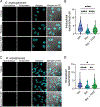An atlas of human vector-borne microbe interactions reveals pathogenicity mechanisms
- PMID: 38876107
- PMCID: PMC11959484
- DOI: 10.1016/j.cell.2024.05.023
An atlas of human vector-borne microbe interactions reveals pathogenicity mechanisms
Abstract
Vector-borne diseases are a leading cause of death worldwide and pose a substantial unmet medical need. Pathogens binding to host extracellular proteins (the "exoproteome") represents a crucial interface in the etiology of vector-borne disease. Here, we used bacterial selection to elucidate host-microbe interactions in high throughput (BASEHIT)-a technique enabling interrogation of microbial interactions with 3,324 human exoproteins-to profile the interactomes of 82 human-pathogen samples, including 30 strains of arthropod-borne pathogens and 8 strains of related non-vector-borne pathogens. The resulting atlas revealed 1,303 putative interactions, including hundreds of pairings with potential roles in pathogenesis, including cell invasion, tissue colonization, immune evasion, and host sensing. Subsequent functional investigations uncovered that Lyme disease spirochetes recognize epidermal growth factor as an environmental cue of transcriptional regulation and that conserved interactions between intracellular pathogens and thioredoxins facilitate cell invasion. In summary, this interactome atlas provides molecular-level insights into microbial pathogenesis and reveals potential host-directed targets for next-generation therapeutics.
Keywords: Lyme disease; arthropod-borne disease; host sensing; host-pathogen interactions; infectious disease; mechanisms of pathogenicity; protein disulfide isomerase; systems biology; thioredoxin; vector-borne disease.
Copyright © 2024 Elsevier Inc. All rights reserved.
Conflict of interest statement
Declaration of interests N.W.P. and A.M.R. are inventors of a patent describing the BASEHIT technique.
Figures





References
MeSH terms
Grants and funding
- R01 AI158615/AI/NIAID NIH HHS/United States
- R01 AI017828/AI/NIAID NIH HHS/United States
- R01 AI153100/AI/NIAID NIH HHS/United States
- R01 AI126853/AI/NIAID NIH HHS/United States
- P01 AI138949/AI/NIAID NIH HHS/United States
- R37 AI017828/AI/NIAID NIH HHS/United States
- R01 AI029735/AI/NIAID NIH HHS/United States
- R01 AI165499/AI/NIAID NIH HHS/United States
- R01 AI139072/AI/NIAID NIH HHS/United States
- R01 AI152220/AI/NIAID NIH HHS/United States
- R01 AI108276/AI/NIAID NIH HHS/United States
- T32 HL007974/HL/NHLBI NIH HHS/United States
- F32 AI174656/AI/NIAID NIH HHS/United States
- S10 OD030363/OD/NIH HHS/United States
- R01 AI167857/AI/NIAID NIH HHS/United States
- P30 CA016059/CA/NCI NIH HHS/United States
- R01 AI116523/AI/NIAID NIH HHS/United States
- R01 AI134696/AI/NIAID NIH HHS/United States
- U19 AI115658/AI/NIAID NIH HHS/United States
LinkOut - more resources
Full Text Sources

